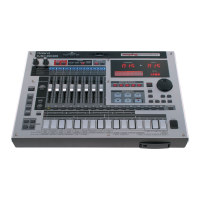53
Playing patterns
Pattern mode
The MC-808’s Arpeggiator function lets you perform arpeggios just by playing the chords, using the notes in the chords you play.
Not only can you use the factory-set
arpeggio styles
, which determine the way the arpeggio is played, but you can also freely
rewrite styles.
Using the arpeggiator
fig.03-050
1.
Press [ARPEGGIO] so its indicator is lighted.
2.
Press a chord using the keyboard pads.
An arpeggio will play according to the specified
arpeggio
style
.
* Arpeggiator cannot be used simultaneously with Pattern Call or RPS.
Selecting an arpeggio style
1.
Hold down [ARPEGGIO] and use the VALUE dial or [INC]
[DEC] to select a style.
“Arpeggio Style list”
(p. 26) in
“Sound & Parameter List”
Modifying the arpeggiator settings
Here’s how to change the way in which the arpeggio is generated.
1.
Hold down [SHIFT] and press [ARPEGGIO].
The arpeggio setup screen will appear.
fig.03-051
2.
Use [CURSOR ] to select a parameter, and turn the
VALUE dial or use [INC] [DEC] to set the value.
Pressing a chord to play an arpeggio (Arpeggiator)
1
2
Using in combination with the chord
memory function
When performing with the Arpeggiator, you can also use it
along with the Chord Memory (p. 56). After first storing
complex Chord Forms in memory, you can then call them up
when Arpeggiator is on, and you can easily create complex
arpeggio sounds just by pressing a single pad.
Parameter
Range Description
Style
(Arpeggio
Style)
Arp Preset:
001–128
Arp User:
001–128
Arpeggio style that you want to
modify (p. 55)
Grid
(
Grid Type
)
1/4,
1/8,
1/8L,
1/8H,
1/12,
1/16,
1/16L,
1/16H,
1/24
Sets the particular note division
and resolution in a “single grid”
used in creating the arpeggio in
an Arpeggio Style, and how
much of a “shuffle” syncopation
is to be to applied (none/weak/
strong) to it.
1/4:
Quarter note (one grid section =
one beat)
1/8:
Eighth note (two grid sections =
one beat)
1/8L:
Eighth note shuffle Light (two
grid sections = one beat, with a
light shuffle)
1/8H:
Eighth note shuffle Heavy (two
grid sections = one beat, with a
heavy shuffle)
1/12
Eighth note triplet (three grid
sections = one beat)
1/16:
Sixteenth note (four grid sec-
tions = one beat)
1/16L:
Sixteenth note shuffle Light
(four grid sections = one beat,
with a light shuffle)
1/16H:
Sixteenth note shuffle Heavy
(four grid sections = one beat,
with a heavy shuffle)
1/24:
Sixteenth note triplet (six grid
sections = one beat)
MC-808_r_e.book 53 ページ 2007年7月17日 火曜日 午後5時1分

